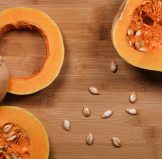
Butternut Squash
We’ve tried a number of ways to store squash, and we’ve been informed over the years by our friends at Seed Savers. If you’ve been canning, chopping and freezing, and cooking things down into sauce this harvest season, you’ll love the ease of storing winter squash whole.
First, be sure the squash are ripe. Each variety differs regarding color and sheen as indicators of ripeness, but as a rule we harvest when the thick stem connecting the fruit to the vine has dried. Cut the stem, leaving at least 1″ and up to 3″ of the stem attached. Be sure to harvest before the first hard frost – if you can’t harvest until after a frost, don’t try to cure and store the squash. Rather, either dice and freeze for later, or bake or make soup and freeze that for later.
Curing is a process that sets up the squash for several months’ of storage by allowing the skin, or shell, to harden. After harvest, elevate the squash off the ground, keeping room between fruits for air to circulate, and leave in a bright, sunny space that isn’t warm or hot for approximately two weeks. You’ll know when they are cured when they pass the ‘fingernail test’ – press your fingernail gently into the shell, and if the skin bruises or breaks, it’s not cured yet! A fully cured squash won’t even dent.
Storage instructions do sound a bit like the porridge in the Goldilocks story – the place you store the squash can’t be too hot or too cold. It needs to be just right! That means not colder than 50 degrees and not warmer than about 65 degrees. The warmer the temperature, the sooner you’ll need to use the squash. Find a cool spot in a closet, the back of a cupboard, a basement, or a garage (if it is temperature controlled). Wrap each squash in paper or straw and place in a box or on a shelf, leaving room for airflow. The paper or straw protects the squash and absorbs any moisture. If the squash does freeze, keep it frozen until you’re ready to use it. Inspect once a week, and use any damaged squash first. Here’s advice from Seed Savers:
- “Any damaged squash should be used as soon as possible.
- Delicatas, Acorns, and Buttercups should be used within a month or two.
- Hubbards, Pie squash, and pumpkins can last up to four months.
- Butternuts last the longest in storage and can take you right into spring.”
And if you don’t have the appropriate space, you can always preserve your squash by dicing and freezing the flesh.
Seed Saving – Seeds last up to a year in your squash – so whenever you use your squash you can scrape out the seeds, rinse and dry, and plant in the spring. Just be aware that squash is a notorious cross-pollinator, and if you grew several kinds you will not necessarily grow a fruit exactly like the one you harvested!
And yes, pumpkins ARE winter squashes. Save them using these same instructions.

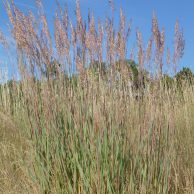
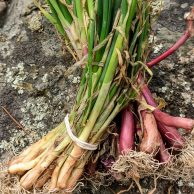
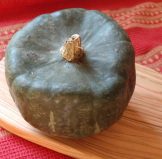
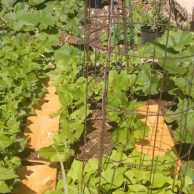 Okay, you prepared your soil and planted your vegetable garden with all kinds of wonderfully flavorful, nutritious foods, you’re watering and watching them grow, and wondering ….. When can I start to eat them, how do I harvest them, and how do I get the most out of these plantings? Here are some tips on vegetable crops harvest timing and techniques that may not be self-evident. Even if you’re a seasoned gardener, you may not be aware of some of these procedures!
Okay, you prepared your soil and planted your vegetable garden with all kinds of wonderfully flavorful, nutritious foods, you’re watering and watching them grow, and wondering ….. When can I start to eat them, how do I harvest them, and how do I get the most out of these plantings? Here are some tips on vegetable crops harvest timing and techniques that may not be self-evident. Even if you’re a seasoned gardener, you may not be aware of some of these procedures! 
 This year’s Taste of Tomato was a blast! We love the new location at Growing Gardens’ Barn, with its’ beautiful view of the Flatirons, easy access, and wonderful staff. The tasting featured 44 different varieties of tomatoes, with Aunt Ruby’s German Green winning the greatest number of votes. Participants brought in some wonderful new varieties this year, including Brad’s Atomic Grape, Thornburn’s Terracotta, and Indigo Cherry. Look for the most popular varieties from this year and previous years when you come to buy your organic tomato starts next spring at Harlequin’s Gardens. Every year we grow 80+ great varieties for all kinds of uses and growing conditions!
This year’s Taste of Tomato was a blast! We love the new location at Growing Gardens’ Barn, with its’ beautiful view of the Flatirons, easy access, and wonderful staff. The tasting featured 44 different varieties of tomatoes, with Aunt Ruby’s German Green winning the greatest number of votes. Participants brought in some wonderful new varieties this year, including Brad’s Atomic Grape, Thornburn’s Terracotta, and Indigo Cherry. Look for the most popular varieties from this year and previous years when you come to buy your organic tomato starts next spring at Harlequin’s Gardens. Every year we grow 80+ great varieties for all kinds of uses and growing conditions!